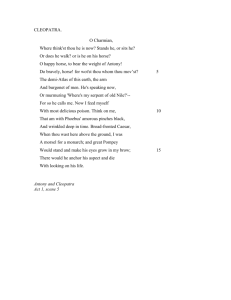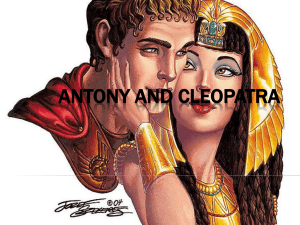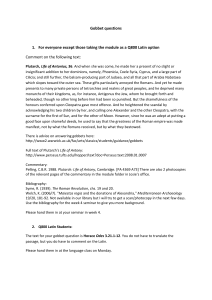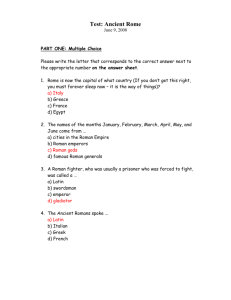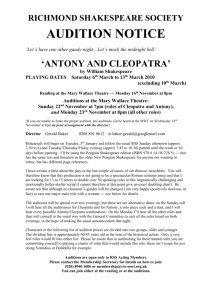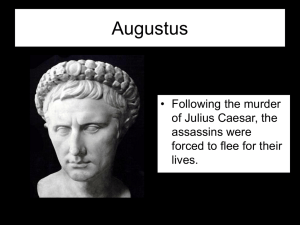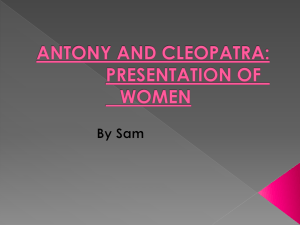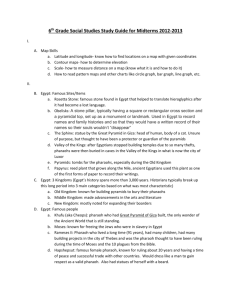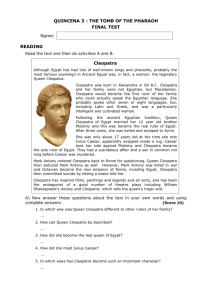Word - Keith Sagar
advertisement
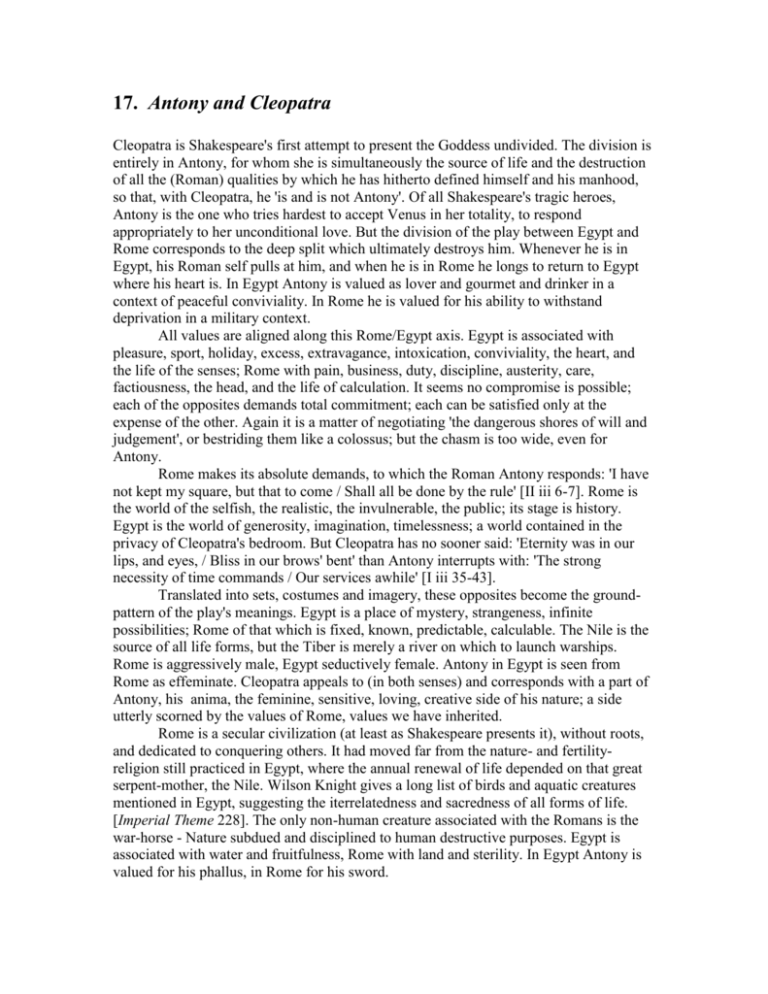
17. Antony and Cleopatra Cleopatra is Shakespeare's first attempt to present the Goddess undivided. The division is entirely in Antony, for whom she is simultaneously the source of life and the destruction of all the (Roman) qualities by which he has hitherto defined himself and his manhood, so that, with Cleopatra, he 'is and is not Antony'. Of all Shakespeare's tragic heroes, Antony is the one who tries hardest to accept Venus in her totality, to respond appropriately to her unconditional love. But the division of the play between Egypt and Rome corresponds to the deep split which ultimately destroys him. Whenever he is in Egypt, his Roman self pulls at him, and when he is in Rome he longs to return to Egypt where his heart is. In Egypt Antony is valued as lover and gourmet and drinker in a context of peaceful conviviality. In Rome he is valued for his ability to withstand deprivation in a military context. All values are aligned along this Rome/Egypt axis. Egypt is associated with pleasure, sport, holiday, excess, extravagance, intoxication, conviviality, the heart, and the life of the senses; Rome with pain, business, duty, discipline, austerity, care, factiousness, the head, and the life of calculation. It seems no compromise is possible; each of the opposites demands total commitment; each can be satisfied only at the expense of the other. Again it is a matter of negotiating 'the dangerous shores of will and judgement', or bestriding them like a colossus; but the chasm is too wide, even for Antony. Rome makes its absolute demands, to which the Roman Antony responds: 'I have not kept my square, but that to come / Shall all be done by the rule' [II iii 6-7]. Rome is the world of the selfish, the realistic, the invulnerable, the public; its stage is history. Egypt is the world of generosity, imagination, timelessness; a world contained in the privacy of Cleopatra's bedroom. But Cleopatra has no sooner said: 'Eternity was in our lips, and eyes, / Bliss in our brows' bent' than Antony interrupts with: 'The strong necessity of time commands / Our services awhile' [I iii 35-43]. Translated into sets, costumes and imagery, these opposites become the groundpattern of the play's meanings. Egypt is a place of mystery, strangeness, infinite possibilities; Rome of that which is fixed, known, predictable, calculable. The Nile is the source of all life forms, but the Tiber is merely a river on which to launch warships. Rome is aggressively male, Egypt seductively female. Antony in Egypt is seen from Rome as effeminate. Cleopatra appeals to (in both senses) and corresponds with a part of Antony, his anima, the feminine, sensitive, loving, creative side of his nature; a side utterly scorned by the values of Rome, values we have inherited. Rome is a secular civilization (at least as Shakespeare presents it), without roots, and dedicated to conquering others. It had moved far from the nature- and fertilityreligion still practiced in Egypt, where the annual renewal of life depended on that great serpent-mother, the Nile. Wilson Knight gives a long list of birds and aquatic creatures mentioned in Egypt, suggesting the iterrelatedness and sacredness of all forms of life. [Imperial Theme 228]. The only non-human creature associated with the Romans is the war-horse - Nature subdued and disciplined to human destructive purposes. Egypt is associated with water and fruitfulness, Rome with land and sterility. In Egypt Antony is valued for his phallus, in Rome for his sword. Antony cannot rid himself of Caesar, yet is continually thwarted and crossed by him. It is not, in Antony, as in Hamlet, that the opposing elements cancel each other out, producing stalemate, inaction. Rather, Antony oscillates between them, like a ship at the mercy of the tides, alternating between actions motivated by his Roman self (his military triumphs) and his 'Egyptian' self (his sensual riots). He cannot long be satisfied with either the Roman or the Egyptian definition of himself. Each denies and violates half of him. When Rome comes to Egypt in the form of his alter ego Caesar, he has to attempt to be general and lover, Roman and Egyptian, simultaneously. For one glorious moment it seems that he has succeeded: Lord of lords, O infinite virtue, com'st thou smiling from The world's great snare uncaught? [IV viii 16-18] But not even Antony is capable of infinite virtue. Antony calls Cleopatra 'my serpent of old Nile'. This should not be registered as a mere tease about her wiliness. It is an image which reverberates throughout the play, and becomes part of a whole pattern of related images. It is from this pattern of images, as in all Shakespeare's mature plays, that the deepest meanings of the play, the symbolic or mythic meanings, emerge. Of all the symbols of ancient Egyptian mythology, the serpent is perhaps the most common and important. At the beginning of the world, the Primordial Snake held all subsequent creation in its folds. It was identified with the Great Goddess, mother of all things. In Egyptian hieroglyphic script the sign for goddess was a rearing cobra. Having neither arms nor legs, the snake seemed to belong not to the animal world, but to a world primeval, even further from the human world. Serpents lived in the dark earth and the depths of the water. They symbolized the energies and dark forces working below the world of appearances. They were worshipped as Water Gods and fertility spirits. The Nile itself, on which the fertility of Egypt depended, was itself a great winding serpent. They were thought to possess the secrets of a lost ancient wisdom. But as gods came to displace goddesses, as Osiris became more important than Isis and became a city rather than an agricultural god, the uncanny forces symbolized by the snake came to be more feared than revered: These serpents are demonic, chaotic powers who dwell in the lower world. ... The forces of nature have to be curbed by 'knowledge'. ... The energy which the serpents have in their mouths is the force of nature. Set against this inchoate energy is intellectual direction. [Clark, 244] The symbolic significance of serpents is much the same in other mythologies. The snake is probably the oldest, commonest and most potent of all theriomorphic images. It is found in Neolithic cultures, where it is also identified with the goddess. The snake is a symbol of vitality and fertility - of life flowing serpentine within all living things, the waters under the earth, the sap of plants, the blood of animals. The snake's ability to renew itself by sloughing its skin suggested the annual renewal of the earth itself. To the early Greeks these limbless, featureless, rapid, vital strips of animate earth or zigzags of the energy of the universe, were not just symbols of but embodiments of zoë, raw, undifferentiated life. The snake was sacred to Dionysos, and to Asklepios, god of healing and renewal. There was also a deeper serpent symbolism which was esoteric, forbidden knowledge. Persephone, in some versions of the myth of her annual descent into the underworld, became a serpent as a bride for the Great Serpent Hades, so that the coupling of serpents came to symbolize the power of life to renew itself. Thus the heart of Nature's mystery was symbolized for the Greeks by the double helix of a pair of entwined mating serpents. The snake was so closely associated with the goddess that when, throughout Europe and the Near East, worship of the goddess was overthrown by the emerging patriarchal religions, the snake inevitably went down with her. Marduk slaughtered the serpent-goddess Tiamat. The great female goddesses, even Earth herself, were rapidly declining in importance. Artemis, for example, stands for the deepest natural bonds between human beings, which cannot be broken without the direst consequences not only for the individual and the family but also for the nation and the race - for Nature itself. But she was gradually dislodged by her brother Apollo, who slew the serpent Python and his mate Delphyne (whose name is connected with an old name for the womb), at the oracular shrine of Mother Earth at Delphi, which he then seized from Hera. Apollo, like Athene, a child of Zeus, belongs to the patriarchal age. He even denies, at Orestes' trial, that woman has a necessary or important role in childbearing (Artemis was the patroness of childbirth). Athene was a goddess born from Zeus' brain without the aid of woman. She employed in her rituals exclusively priests, not priestesses. All this is part of the process Slater calls 'dematrification'. When the role of the male in procreation became known, the shape of the snake and its ability to erect itself suggested the fertilizing phallus of the goddess' consort. Thus when the goddess herself ceased to be depicted as a serpent, the serpent continued to be depicted alongside her. But in later ages such images came to be reinterpreted, according to ideological prejudice or conditioning, often with exactly the opposite meaning. There is, for example, the image of a male and female being on either side of a flourishing tree. Associated with the female is a serpent. Originally, the image was interpreted as the Great Goddess, Mother of All Things, through whom the life force (the serpent) becomes the fertile world (Tree of Life). Chief among her creations is the male, who now, as her consort, honours and balances her. The same image appearing in Judeo-Christian culture is interpreted as sinful Eve being seduced by the evil serpent to taste the forbidden fruit and betray her consort, thus spoiling the perfect world which had sprung from the mind of God. The serpent is the first to receive Yahweh's curse: 'Upon thy belly shalt thou go, and dust shalt thou eat all the days of thy life...' (Gen. 3:14). No longer is he to be the ever-rising sap of the Tree of Life, supreme among all others; now he is cursed above cattle and every beast of the field. His former vertical posture, as it would seem in the light of later developments, has been appropriated. ... [A] serpent of brass stood in the temple of Jerusalem, together with the Asherah, or image of the Mother Goddess, for about 200 years, until King Hezekiah 'did what was right in the sight of the Lord' (2 Kgs. 18:3). [Baring 500] The snake is now the Universal Enemy and, through the woman, the origin of all evil. At the time of Cleopatra, the Goddess had already been dethroned and degraded in Europe and much of the near East, but not yet in Egypt. Nowhere had the process of dematrification gone further than in Rome, a patriarchal society dedicated to the masculine and militaristic virtues of conquest, domination, discipline, efficiency, and every kind of rigidity. To such an extent were all things feminine repressed, including the feminine element in the male psyche, that love was reduced to either the legalistic, in which form it became part of the economic and political structure, or the erotic, in which form it was part of the warrior hero's permitted relaxation, like heavy drinking. Actual women are thus allowed only two roles, either dutiful wife or exciting whore. All conception of the sacred wholeness of the goddess as source of life and death was lost. Octavius would put the goddess in a cage as a public entertainment. I am not suggesting that Shakespeare knew anything of Egyptian mythology. His immediate source, Plutarch, gives barely a hint of it. He would have known Greek mythology only in the degraded form in which it is relayed by the Latin authors. Of other mythologies he probably knew little or nothing. Yet it was not necessary for Shakespeare to know any mythology in order to make effective and mythologically accurate use in Antony and Cleopatra of serpent imagery and such related images as water and mud, for these images are archetypes, that is to say, images which have always occurred with much the same charge of meaning, in widely different cultures, independently of time and place, in dreams, visions, drug-induced hallucinations, and in the imaginations of poets. Serpents, for example, are so common in myths because they are an essential part of the symbolic language of the human psyche. And what they symbolize is life-giving female energies suppressed by the hubristic male intellect into the cellars of the mind, there to turn at last poisonous and destructive in response to rejection and persecution. In the opening lines Antony's 'dotage' is expressed in terms of Mars disarmed by Venus. Mars stands for the absoluteness of manhood as defined in military terms, and Venus for the absoluteness of womanhood and the claims of love. Each needs the other, and each destroys the other. As Cleopatra triumphs, the god Hercules leaves Antony, and leaves him broken. Nothing in Roman mythology can put him together again, restore his integrity. He dies in disgrace and in error, bungling even his suicide. Cleopatra is , finally, very like Venus at the end of Venus and Adonis. The man she loves has been unable to meet the demands of her love. His betrayal of her draws out the destructive side of her nature, turns her serpent power to poison. But I am clearly not describing here the end of the play as we have it; rather, how the play might have ended had it been written in the spirit of Troilus and Cressida. Cleopatra is Venus only in fancy dress, as a tribute to Antony and the mythology he is familiar with. Her real mythic significance emerges from her native Egyptian mythology, where she is, as she herself claims, Isis, mother of the gods, and wife of the god-king fertility hero Osiris, whose fate is to be torn apart, then reintegrated through her. But the Romans no longer recognized the absolute divinity of the great goddess; in their consciousness, as in the Judaic and the Christian, she had become the great whore. In their terms, Cleopatra is no more than a gypsy and a strumpet. Sylvia B. Perera writes: Most of the powers once held by the goddesses have lost their connection to women's life: the embodied, playful, passionately erotic feminine; the powerful, independent, self-willed feminine; and the ambitious, regal, many-sided feminine. ... Thus constricted, the joy of the feminine has been denigrated as mere frivolity, her joyful lust demeaned as whorishness, or sentimentalized and maternalized, her vitality channelled into duty and obedience. [Lauter 147-8] Cleopatra is the magical doorway into life. Wilson Knight says of her: In Shakespeare woman is both the divine ideal and the origin of evil: because she is more eternal than man, more mysterious, the mysterious origin of life. On that dualism the past agonies revolve. Woman, rather than man, is the creative essence, the one harmony, from which man is separated, to which he aspires. On her ultimate serenity and sweetness, not denying but overswamping her evil, depends the sanity of religion, and the universal beauty. [op.cit.316-17] Though we, like Shakespeare, must find heart more attractive than head, Egypt more attractive than Rome, Cleopatra than Caesar, Shakespeare by no means devalues Antony's military exploits nor does he always glamorize his erotic life. It is glamorous, almost divine in its excess, but it is also, simultaneously, reducible to a matter of drunkenness and gaudy nights. Antony himself, at his lowest point, utters the play's strongest condemnation of it: the wise gods seal our eyes; In our own filth dip our clear judgements; make us Adore our errors; laugh at's, while we strut To our confusion. [III xiii 112-15] In Troilus and Cressida that would have been the last word, but it is not here. In spite of the worst that can be said against it, there is also a sense, which grows throughout the play, in which Cleopatra mysteriously redeems what to Roman consciousness is most vile: For vilest things Become themselves in her, that the holy priests Bless her, when she is riggish.[II ii 238-40] Joyful lust is sacred. After his death, Cleopatra is able to substitute for the torn Antony a regenerate man embodying the wholeness he never achieved in life, a man whose capacity for fullness and joy in life integrates human life with that of the non-human world and triumphs over death: For his bounty, There was no winter in't: an autumn 'twas That grew the more by reaping: his delights Were dolphin-like, they show'd his back above The element they lived in. [V ii 86-90] We now recognize over a hundred elements. In Shakespeare's day there were, and had been since the early Greeks, only four, earth, air, fire and water. Earth and water were regarded as gross elements which bound the nature of man to that of beasts. Air and fire were refined and linked man's composition to that of the spirits. The orthodox attitude, supported by Christianity, was that men should disown and suppress their grosser elements and do all they could to express only the finer. But there were those, including Shakespeare, who believed that man's task was rather to achieve a balance, a harmony of the potentially discordant elements of which he was composed; and that to fail to do so was to give oneself as a hostage to fate. To the male intellect which aspires to a life all air and fire (that is renown and conquest), earth and water, the dominion of the serpent, are spurned as mere mud from which men have painfully dragged themselves (rising above women in the process), and Antony's lapse is a disgusting slide back into man's first slime. But Cleopatra looks back on Antony in his brief moment of perfect balance as a dolphin, simultaneously a creature of air and water. Life is no longer in this play seen as a doomed battle against 'injurious time' and oblivion. Shakespeare's understanding of Egyptian religion, or the meaning with which he invests it for the purposes of this play, is very close to the meaning of Etruscan religion as Lawrence deduced it from the tomb-paintings: In the tombs we see it; throes of wonder and vivid feeling throbbing over death. Man moves naked and glowing through the universe. Then comes death: he dives into the sea, he departs into the underworld. ... But the sea the people knew. The dolphin leaps in and out of it suddenly, as a creature that suddenly exists, out of nowhere. He was not: and lo! there he is! The dolphin which gives up the sea's rainbows only when he dies. Out he leaps; then, with a head-dive, back again he plunges into the sea. He is so much alive, he is like the phallus carrying the fiery spark of procreation down into the wet darkness of the womb. The diver does the same, carrying like a phallus his small hot spark into the deeps of death. And the sea will give up her dead like dolphins that leap out and have the rainbow within them. [Mornings in Mexico 150-1] Thus the sea gave up the dead Osiris to Isis in search. Historically, the Romans did accuse the life-loving Etruscans of sexual viciousness. The Romans aspired to clear judgements in their doomed masculine pursuit of perfection. In Egypt nothing is clear, everything muddied, for their life is complete and does not disown its miraculous origins in the slime: The higher Nilus swells, The more it promises: as it ebbs, the seedsman Upon the slime and ooze scatters his grain, And shortly comes to harvest. [II vii 20-3] This is the context in which Cleopatra envisages her death, as preferable to life in Rome: Rather a ditch in Egypt Be gentle grave unto me, rather in Nilus' mud Lay me stark-nak'd, and let the water-flies Blow me into abhorring. [V ii 57-60] Cleopatra here becomes the Black Goddess, as in Peter Redgrove's poem 'The Idea of Entropy at Maenporth Beach', where 'the mud spatters with rich seed and raging pollens' as the white woman enters black mud for earth's blessing. And the abhorrent crawling things, as the Ancient Mariner was to discover, are also sacred. It becomes clear in such passages how close Shakespeare's drama is to what Hughes calls 'the drama of organic life': life itself is what terrifies living things and possesses them with their various forms of madness, and exhausts them with their struggles to control and contain it and to secure its subjective essence of joy. [Shakespeare 326] As in all tragedy the ending is a mixture of positive and negative elements. In terms of that part of our consciousness (and Shakespeare's) which regards death as final, we might say that no creative marriage has been possible in life between the mighty opposites of Rome and Egypt, male and female, ancient and modern, religious and secular, rational and irrational. Cleopatra, the Divine Mother, puts to her breast not a baby but an asp. Instead of milk flowing from her breast poison flows into it. Only by consigning her body to the mud and becoming all fire and air, only, that is, in death, can she achieve her marriage. Yet death cannot negate what the play has in human terms affirmed: that, in the last analysis, living one's life, participating in the life-processes of eating and drinking and making love and having children and relating to other people and to the non-human world in a spirit of joy is more important than any amount of power and conquest and male self-glorification; that to uphold such values is not simply play or childishness or effeminacy, but requires a total commitment, a willingness to sacrifice a great deal for it, and the final recognition that death is not a defeat and an ending, but another of nature's sacred processes; that participation in it can be a triumph and a blessing. Having committed themselves to each other, and to a 'better life' in death, Antony and Cleopatra, like Lear and Cordelia in prison, are lifted into an almost godlike spiritual condition (symbolized by Cleopatra lifting the dying Antony to the top of her monument), from which vantage point it can be seen that Caesar is paltry, 'an ass unpolicied', and all things political are dwarfed into insignificance. By the time we reach the ending the reader sensitive to the imagery has been conditioned to recognize also a mythic plane of meaning on which death is by no means final. Antony calls to Cleopatra to stay for him: Where souls do couch on flowers, we'll hand in hand, And with our sprightly port make the ghosts gaze: Dido, and her Aeneas, shall want troops And all the haunt be ours. [IV xiv 50-4] Unconsciously, Antony reunites the abandoned queen with her betrayer in the Elysian Fields, where Aeneas is given a second chance to accept Dido's unconditional love. 'I will be a bridegroom in my death' [IV xiv 100] is taken up by Cleopatra: 'Husband, I come: / Now to that name, my courage prove my title!' [V ii 286-7]. She claims the title not only of bride, but also of mother: : 'Dost thou not see my baby at my breast, / That sucks the nurse asleep?' [V ii 308-9]. (One of the several Egyptian serpent-headed goddesses, Renenet, was the goddess of suckling.) Behind the final tableau stands Isis giving new life to the dead Osiris and giving birth to his son Horus who will grow to be the renewed Osiris. The Goddess is able at last to achieve her completeness assuming those aspects denied her by Rome, and, until now, by Antony - Divine Mother and Sacred Bride. Hughes traces in detail Antony's role as Osiris to Cleopatra's Isis. Here is his account of the ending: What now remains, for this Osirian Antony, is for him to free himself, wholly and finally, from that obsolete Herculean Roman Antony, and emerge as his true self, the universal love god, consort of the Goddess of Complete Being, in so far as that can be incarnated in the body of the middle-aged Roman warrior, lover of a middleaged, reckless, fearful queen.... While the drama portrays the self-destruction of the great Roman Antony on the tragic plane, it becomes, on the transcendental plane, a theophany, the liberation of Antony's Osirian Divine Love nature, under the 'magical' influence of the completeness of Cleopatra's. The play ... begins with the love god fully formed but unacknowledged, trapped within the self-ignorant, military Herculean bon viveur, who is still confidently wrestling for political control of the Roman world. It ends with the crushed, empty armour of the former Herculean warrior, like an empty chrysalis, while the liberated love god, like an iridescent new winged being, lies in the lap of the Goddess, his love 'total and unconditional', reunited beyond life and death (in the high tomb) with the adoring Goddess. [Shakespeare and the Goddess of Complete Being, 316-7] This image may seem less far-fetched when we think of Coriolanus dying in his belated attempt to emerge from the armoured chrysalis in which his mother has locked him, (she had no doubt tought him, as she now teaches his son, to mammock gilded butterflies); of the emergence of life from a coffin in Pericles; and from a stone statue in The Winter's Tale. [© Keith Sagar 2001. This essay may be quoted with due acknowledgement.]
